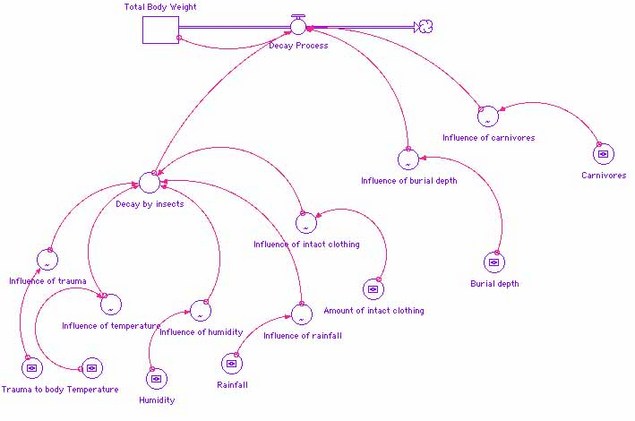Decomposition of a Human Body
Background:
A decomposing corpse, which has been discovered lying in a wooded area, secluded lot, or in an open field, presents the forensic scientist with many questions to be answered. One of the most important questions is the "time interval since death." The answer to this question is, in many cases, crucial to establishing the identity of the individual. Forensic scientists faced with this question must rely on their experience of previously known cases. This results in a rough estimation of time since death, based on nonspecific criteria.
In this case study, you are tasked to build a simulation to measure time needed for a human cadaver of some total body weight to decompose down to skeleton. Model building specifics are described below.
Building the Model:
A human cadaver lying in a field (or buried some depth) can undergo only one process: decay. Decay of the body is a time-dependent phenomenon that depends directly on three processes:
- Decay by insects, primarily maggots
- Depth of the burial in the ground (assuming no casket or other external protective objects)
- Number of carnivores active in the area.
Decay by insects is determined by five factors:
- Trauma to the body (open wounds, etc.)
- Temperature
- Humidity
- Rainfall
- Amount of clothing on body
Each of the factors has a certain "weight"; that is, some factors influence decay more than others. These weights are shown as an activity: that is, an input graph for each factor of the actual quantity and its subsequent influence on the decay process must be utilized.
For your model, you might wish to try these settings, then investigate your own settings:
- Total body weight: 150 lbs.
- Burial depth: 2 feet
- Carnivores: 25
- Clothing: 60 percent
- Humidity: 65 percent
- Rainfall: 2 inches
- Temperature: 15 degrees Celsius
- Trauma to the body: 50 percent (pretty beat-up!)
Keep in mind that you are looking for the decay of the body over time. If your body gains weight, you might want to re-consider the mathematics of your model!
Source: "Insect Activity and its Relationship to Decay Rates of Human Cadavers in East Tennessee", William Rodriquez and William Bass, Journal of Forensic Sciences, JFSCA, Vol. 28, No. 2, April 1983, pp. 423-432.
The Model:
Stella® model and case study by Bob Gotwals. Below you will find an image of a model of dead body decomposition. This model was created using Stella software and was converted to Java for the web using Stella2Java.
Click here to view the model. Please note that in order to view this Java applet you must use a Java-enabled browser.
As with any model, this one has been simplified in order to demonstrate change in body weight over time. This model could be added to in such a way that it would more closely represent real decay processes in a given geographic area. Manipulate the variables below to see how they change the rate of decomposition.
